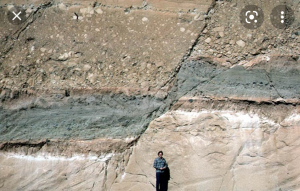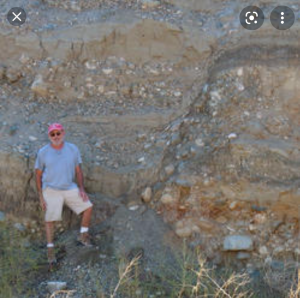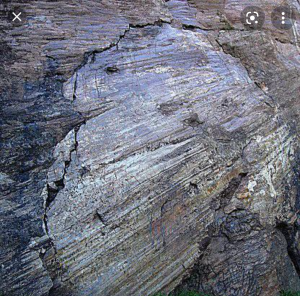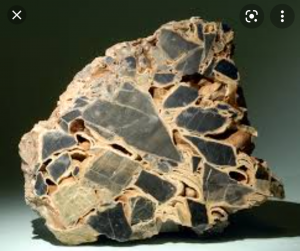- Jun 15, 2017
- 9,649
- 3,262
- Country
- United States
- Gender
- Male
- Faith
- Christian
- Marital Status
- Married
- Politics
- US-Republican
So I was peeling through some photos of Ken Hams ark encounter displays and I stumbled across an honorable mention:

So this is a classic case of a really problematic anti-scientific position that is YECism.
The presentation basically suggests that dense and hardened rocks break when they are subjected to pressure and deformation.
And so by this logic, if rock is not fractured and broken, but rather is wavy and ductile, then this rock therefore was not lithified and hardened, and by this logic, it was likely deposited by a global flood.
So now that we've broken down the ark encounters claim, we can examine if it's true.
I'm a geologist (by career, research, hobby and license) and it's easy for me to speak on these things, so here goes.
I've been to countless rock formations up and down the east coast of the US and in some cases abroad. It's very common in the earth to find faults in rock formations.
So common that, anyone reading this now, if you go to a rock outcrop near you, you will have a high probability of finding a fault. They're everywhere.

What ken Hams ark encounter doesn't talk about, are things like antithetic faults, where minor faults occur perpendicular to a large fault. Nor does the encounter talk about how thrust faults typically break at 90° angles or that normal faults typically break at 60° angles.
View attachment 301109
We have things like slickensides between faults, where rocks essentially carve and polish one another as they grind past eachother.


Brecciated fault gouge is also very common in the angular unconformities. Breccias associated with these unconformities being angular fragmented jumbles of deposits caught between two crushing massive bodies of rock.

And so, it becomes quite clear that in actuality, it's quite common that we find evidence, or more specifically, proof, that in between really every single period of geologic history, and throughout the entire history of earth, these were massive bodies of rock that were being deformed, and not actually soft sediment as the post would have us believe.
But there is still a question of why these other bodies of rock are folded and bent, but not broken.
Which is to say that these are rocks that have been heated and melted.
Additional thoughts on folding of layers:
Not sure how I made that jump from sedimentary to metamorphic and back to sedimentary topics, but anyway, It has come to my attention that the poster does distinctly depict sedimentary rock, and not metamorphic. No matter though, the causes of folding are the same in the vast majority of cases. And apparently some YECs have a history of overlooking fractures and brecciated material in folded sedimentary rock. I think it would be fair to ask the question of if the ark encounter poster accurately depicts the earth to begin with. Which is to say that if we were to find an outcrop much like the one in the poster, if we looked closely at it, is it even true that we would not find fractures within it? And the answer is that you would find fractures in it. In which case, the posted is a big giant straw-man to begin with. Which is really unfortunate for this ark encounter poster because it makes it even more dishonest than it already was. End of additional thought.
So every rock has its own physical properties. Some rocks have lower melting points than others and melt at different temperatures than others.
But overall it's quite simple that every rock, when heated, much like a piece of plastic, can bend. And with enough heat, they become similar in state to something like play doh.

And there are many studies on brittle and ductile deformation, studies on various types of rocks where people stick rocks in machines and in ovens and crush them to see how they break and fold.
There's nothing abnormal about any of this. It's just the science of structural geology.
So basically as rock is buried and otherwise subducts or has its melting pressure lowered by tectonic motion, it folds rather than breaks.
But I will throw in one other detail to help bring this concept to life, and that is sheared and strained bilaterally symmetric fossils or otherwise symmetric "strain markers" as they are known.
I'll have to make a second OP because I have an "image limit". So I'll continue to a second post.
So this is a classic case of a really problematic anti-scientific position that is YECism.
The presentation basically suggests that dense and hardened rocks break when they are subjected to pressure and deformation.
And so by this logic, if rock is not fractured and broken, but rather is wavy and ductile, then this rock therefore was not lithified and hardened, and by this logic, it was likely deposited by a global flood.
So now that we've broken down the ark encounters claim, we can examine if it's true.
I'm a geologist (by career, research, hobby and license) and it's easy for me to speak on these things, so here goes.
I've been to countless rock formations up and down the east coast of the US and in some cases abroad. It's very common in the earth to find faults in rock formations.
So common that, anyone reading this now, if you go to a rock outcrop near you, you will have a high probability of finding a fault. They're everywhere.
What ken Hams ark encounter doesn't talk about, are things like antithetic faults, where minor faults occur perpendicular to a large fault. Nor does the encounter talk about how thrust faults typically break at 90° angles or that normal faults typically break at 60° angles.
View attachment 301109
We have things like slickensides between faults, where rocks essentially carve and polish one another as they grind past eachother.
Brecciated fault gouge is also very common in the angular unconformities. Breccias associated with these unconformities being angular fragmented jumbles of deposits caught between two crushing massive bodies of rock.
And so, it becomes quite clear that in actuality, it's quite common that we find evidence, or more specifically, proof, that in between really every single period of geologic history, and throughout the entire history of earth, these were massive bodies of rock that were being deformed, and not actually soft sediment as the post would have us believe.
But there is still a question of why these other bodies of rock are folded and bent, but not broken.
Which is to say that these are rocks that have been heated and melted.
Additional thoughts on folding of layers:
Not sure how I made that jump from sedimentary to metamorphic and back to sedimentary topics, but anyway, It has come to my attention that the poster does distinctly depict sedimentary rock, and not metamorphic. No matter though, the causes of folding are the same in the vast majority of cases. And apparently some YECs have a history of overlooking fractures and brecciated material in folded sedimentary rock. I think it would be fair to ask the question of if the ark encounter poster accurately depicts the earth to begin with. Which is to say that if we were to find an outcrop much like the one in the poster, if we looked closely at it, is it even true that we would not find fractures within it? And the answer is that you would find fractures in it. In which case, the posted is a big giant straw-man to begin with. Which is really unfortunate for this ark encounter poster because it makes it even more dishonest than it already was. End of additional thought.
So every rock has its own physical properties. Some rocks have lower melting points than others and melt at different temperatures than others.
But overall it's quite simple that every rock, when heated, much like a piece of plastic, can bend. And with enough heat, they become similar in state to something like play doh.
And there are many studies on brittle and ductile deformation, studies on various types of rocks where people stick rocks in machines and in ovens and crush them to see how they break and fold.
There's nothing abnormal about any of this. It's just the science of structural geology.
So basically as rock is buried and otherwise subducts or has its melting pressure lowered by tectonic motion, it folds rather than breaks.
But I will throw in one other detail to help bring this concept to life, and that is sheared and strained bilaterally symmetric fossils or otherwise symmetric "strain markers" as they are known.
I'll have to make a second OP because I have an "image limit". So I'll continue to a second post.
Attachments
Last edited:





